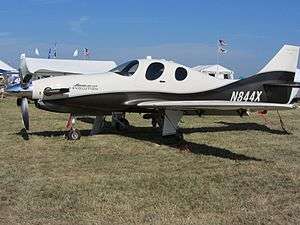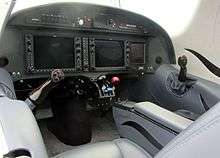Lancair Evolution
| Evolution | |
|---|---|
 | |
| Role | Kit aircraft |
| National origin | United States |
| Manufacturer | Lancair Evolution Aircraft |
| First flight | 21 March 2008 |
| Introduction | July 2009 |
| Status | Production completed (October 2017) |
| Number built | 1 piston Evolution (2011)[1] +70 turbine Evolutions (Sep 2016)[2] |
| Unit cost |
US$1.0M (completed turbine-powered aircraft, 2015)[3] |
The Lancair Evolution is an American pressurized, low wing, four-place, single engine light aircraft, made from carbon fiber composite, developed by Lancair and supplied as an amateur-built kit by Evolution Aircraft.[1][4][5][6]
The Evolution can be powered by a Lycoming TEO-540-A piston engine or a Pratt & Whitney PT6-135A turboprop powerplant.[1][4][5][7][8]
Development
The Evolution was designed to meet the same FAR Part 23 aircraft certification standards that type certified aircraft comply with. The kit includes energy absorbing seats.[4]
The aircraft is pressurized and was designed for a 6.5 psi (0.45 bar) differential pressure, giving an 8,000 ft (2,438 m) cabin pressure at its maximum altitude of 28,000 ft (8,534 m).[9]
The turbine version of the Evolution is powered by the 750 hp (559 kW) Pratt & Whitney PT6A-135A and has a maximum cruise of 300 kn (556 km/h) at 25,000 ft (7,620 m) on a fuel burn of 39 US gal (148 l) per hour of Jet-A. Cruising at an economy cruise of 270 kn (500 km/h) at 28,000 ft (8,534 m) it burns 23 US gal (87 l) per hour. It has a full-fuel payload of 837 lb (380 kg) and a 61 kn (113 km/h) flaps-down stall speed.[8]
The piston version is powered by a Lycoming TEO-540-A2A engine and has a maximum cruising speed of 270 kn (500 km/h) on a fuel burn of 22 US gal (83 l) per hour of avgas. At an economy cruise speed of 240 kn (444 km/h) the fuel flow is 17.5 US gal (66 l) per hour. It has a full-fuel payload of 773 lb (351 kg) and a 61 kn (113 km/h) flaps-down stall speed.[7] A second piston variant was introduced in April 2016, powered by a Lycoming iE2 engine of 350 hp (261 kW).[10]
The first customer kit was delivered on 22 July 2008 and production was planned at that time for two kits per month.[11] By December 2011 one piston model and 15 turbine models had been completed and flown. Construction time from the supplied kit is estimated as 1000 hours.[1]
In April 2017 the manufacturer announced new turboprop engine options for the design. The Evolution Turbine can be fitted with three different variants of the Pratt & Whitney PT6 turboprop powerplant producing 550 hp (410 kW), 750 hp (559 kW) and 867 hp (647 kW), respectively. The latter version cruises at 330 kn (611 km/h).[12]
In October 2017, the Aircraft Owners and Pilots Association reported that the manufacturer appears to have shut down. The cause seems to have been several high-profile accidents which made obtaining liability insurance impossible.[13]
Specifications (Evolution with PT6)

Data from Lancair and Kitplanes[1][8][14]
General characteristics
- Crew: one
- Capacity: three passengers
- Length: 30 ft (9.1 m)
- Wingspan: 37 ft (11 m)
- Height: 10 ft (3.0 m)
- Wing area: 132 sq ft (12.3 m2)
- Empty weight: 2,350 lb (1,066 kg)
- Gross weight: 4,350 lb (1,973 kg)
- Fuel capacity: 168 U.S. gallons (640 L; 140 imp gal)
- Powerplant: 1 × Pratt & Whitney PT6A-135A turboprop aircraft engine, 750 hp (560 kW)
Performance
- Maximum speed: 219 mph; 352 km/h (190 kn) maximum cruise speed (indicated airspeed)
- Cruise speed: 345 mph; 556 km/h (300 kn) true airspeed
- Stall speed: 70 mph; 113 km/h (61 kn) flaps down
- Never exceed speed: 295 mph; 474 km/h (256 kn) indicated airspeed
- Range: 1,304 mi; 2,098 km (1,133 nmi) at maximum cruise speed
- Service ceiling: 28,000 ft (8,500 m) limited by RVSM
- Rate of climb: 4,000 ft/min (20 m/s)
- Wing loading: 33.0 lb/sq ft (161 kg/m2)
See also
- Related Aircraft
References
- 1 2 3 4 5 Vandermeullen, Richard: 2012 Kit Aircraft Buyer's Guide, Kitplanes, Volume 28, Number 12, December 2011, page 58. Belvoir Publications. ISSN 0891-1851
- ↑ "Evolution presentation". evolutionaircraft. Retrieved 21 September 2016.
- ↑ Tacke, Willi; Marino Boric; et al: World Directory of Light Aviation 2015-16, page 113. Flying Pages Europe SARL, 2015. ISSN 1368-485X
- 1 2 3 Lancair International (2012). "Performance Evolved..." Retrieved 20 October 2012.
- 1 2 Bayerl, Robby; Martin Berkemeier; et al: World Directory of Leisure Aviation 2011-12, page 106. WDLA UK, Lancaster UK, 2011. ISSN 1368-485X
- ↑ Grady, Mary (14 February 2017). "Lancair Brand Under New Ownership". AVweb. Retrieved 15 February 2017.
- 1 2 Lancair International (2012). "Evolution Piston Specs". Retrieved 12 December 2012.
- 1 2 3 Lancair International (2012). "Evolution Turbine Specs". Retrieved 12 December 2012.
- ↑ Lancair International (April 2009). "LANCAIR'S EVOLUTION AIRCRAFT COMPLETES A MAJOR TESTING PHASE with FLYING COLORS". Retrieved 2009-09-28.
- ↑ "Lancair Debuts Piston Evolution". AVweb. Retrieved 8 April 2016.
- ↑ Lancair International (July 2008). "First Evolution Kit Delivered". Retrieved 2009-09-28.
- ↑ Rapoport, Geoff (28 April 2017). "Evolution Adds Two More PT6 Options". AVweb. Retrieved 1 May 2017.
- ↑ "Evolution Aircraft Co. appears to have shuttered". www.aopa.org. 19 October 2017. Retrieved 19 August 2018.
- ↑ Editors (March 2014), Pilot's Operating Handbook and Airplane Flight Manual (PDF), Evolution, Redmond, Oregon: Lancair International, Inc., retrieved 2015-09-06
External links
| Wikimedia Commons has media related to Lancair. |